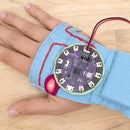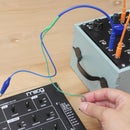Introduction: Intro to EL (Electroluminescent) Wire
At it's core, EL wire is a thin, flexible wire coated in phosphor, when alternating current (AC) is applied it glows brightly. In order to apply AC power, inverters are used to transform battery power (DC) to the necessary requirements. EL tape, panels and EL paint (we won't be getting to that here) work in the same way, they are just in different forms. All these products come in a rainbow of colors, EL wire, being the most used, offers up the biggest selection.
In this Instructable you will learn how to work with each of these EL products and control them using an Intel Edison microcontroller. Digital (your blink) and analog (your fade) will be covered, as well as how to map and trigger these effects to a button and potentiometer.
Step 1: Material Overview
EL products work the same electrically and are all thin and flexible, making them great for all sorts of project. They can be sewn in, wrapped around and glued to clothing, bikes, interiors and anything else imagined. When purchasing, make sure to get an inverter if the product doesn't already come with one. This inverts DC battery power to AC, which is what EL materials need to turn on. Most inverters have blinking sequences built in to them, I suggest getting one that does not, it can potentially get in the way later if it needs to be opened up and modified. An inverter will come mounted in a battery case, or on it's own, both examples are shown in the next step.
El wire can be found in different diameters ranging from .9mm to 5mm and in an assortment of colors. It can come on a reel or cut at specific lengths, usually in meters. Wires can be daisy-chained together to produce longer or multicolored lengths. Adafruit has a great tutorial on how to solder to EL wire.
EL panels are large flat surfaces usually ranging from 10cm X 10cm to 84cm x 50cm. They come in all kinds of dimensions, so if you need something very specific do a little research online to see what's out there. Panels provide a nice even, bright glow across it's surface which makes it great for signage and backlighting. The cool thing about them is they can be cut into shapes, as long as the connector is kept on the panel. Some larger panels have multiple places where it can be connected that allows it to be cut into multiple shapes.
EL tape is much like it's panel sibling except it comes in smaller widths and longer lengths. Usually found in .5" up to 1.5" widths, it comes in reels or cut to length.
Step 2: Power
Since electroluminescence requires AC current, EL wire can not be controlled directly by a microcontroller. Therefore you need an inverter (driver) and a triac.
The inverter needed will depend on how long your EL wire is, an inverter can either be powered by 3V, 9V and 12V batteries or by 110 Volts AC wall current. Buy the inverter that is recommended by the EL product distributors you are purchasing from. Coolneon.com has a variety of inverters based on the length you are looking to purchase. The amount of EL wire/panel/tape that can be powered by a recommended inverter should be mentioned in the description of the product as seen on sparkfun.com.
A TRIAC is a kind of electronic switch that works with AC power. It allows the external power to flow to the EL component the Edison pin is turned on.
Step 3: Circuit for Digital Output
Send an on/off digital signal to your EL material to make it blinky or hook it up to be triggered by a switch (we'll get to that in step 5).
Gather the materials below and hook up the circuit as illustrated. The code is for use with the Arduino breakout board.
You will need:
(1) EL panel or
up to 3 meters of EL wire or
1 meter of EL tape
Adafruit has a wide variety of neat EL products that are ready to plug in, check the Going Further step for more resources
(1) Inverter
(1) 100 Ohm resistor
(1) TRIAC (shown is a 2N6071A, this one works too)
(1) Breadboard
(1) Edison with mini or Arduino breakout board
(some) Jumper wires
Attachments
Step 4: Circuit for Analog Output
Want the EL wire to do something else other than blink? With a transistor before the inverter, the DC power supply can be PWMed via the Edison.
Gather the materials below and hook up the circuit as illustrated. The code is for use with the Arduino breakout board.
You will need:
(1) EL panel or
up to 3 meters of EL wire or 1 meter of EL tape
Adafruit has a wide variety of neat EL products that are ready to plug in, check the Going Further step for more resources
(1) Inverter
(1) 1K resistor
(1) Edison with mini or Arduino breakout board
Attachments
Step 5: Add Inputs
Now that you know how to connect EL wire to a microcontroller and get it to fade or blink, let's add some inputs! For analog input the Arduino shield needs to be used since it supports ADC (analog digital conversion). If using the mini breakout board, you will need to hook up external hardware in order to support analog input.
Depending on what you want to do, gather the materials from the previous steps plus what is listed below.
Digital - To blink EL wire with a push of a button, use the materials required for the digital output circuit plus:
(1) Switch
(1) 10K Ohm resistor
(more) Jumper wires
Analog - To fade EL wire using a potentiometer, use the materials required for the analog output circuit plus:
(1) Potentiometer
Step 6: Uploading to the Edison
The Edison can be programmed via the Eclipse and Arduino IDE. Languages that can be used are C/C++, Arduino language and Javascript.
Intel has extensive documentation on their website for the Edison and Galileo. Below are listed some main steps to be aware of when preparing to upload a program along with links to the relevant pages. For more details and documentation, check out Intel’s Get Started page. There, you will learn how to assemble hardware, download software and find demos along with example code.
Arduino
First, get your Edison flashed with the latest firmware and learn how to connect it to your computer through the USB serial port. Download Intel’s Arduino IDE , when you open it you will see the Intel Edison and Galileo boards under the Tools menu. An understanding of Arduino is recommended before getting started with Intel’s version.
Recommended reading: Getting Started with Arduino
Follow these steps to upload your first blink sketch.
Eclipse
To upload a program via Eclipse, you need to connect the Edison and your computer to the same WiFi network, with the Arduino IDE, it’s not necessary. After flashing the latest firmware and connecting the board to the USB ports, visit Intel's Get Started page and choose how you want to get your board online.
If programming in C/C++, Intel provides example code on their Github MRAA and UPM library pages. Follow the steps on Intel’s website for how to install the Eclipse IDE and how to create a new project , which shows how to upload the blink program via Eclipse to get you started.
If you get stuck, the best place for help with troubleshooting is Intel’s forum.





